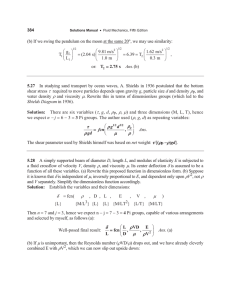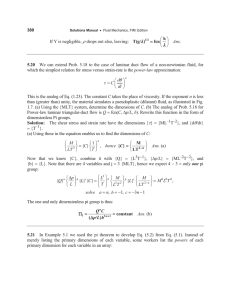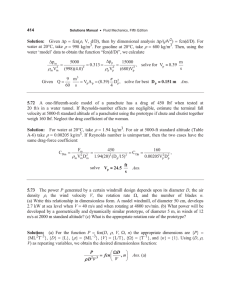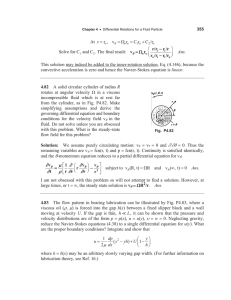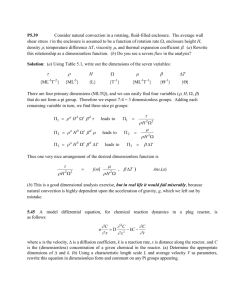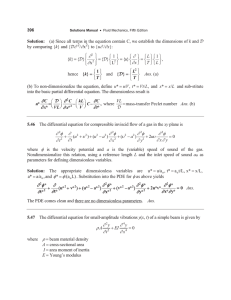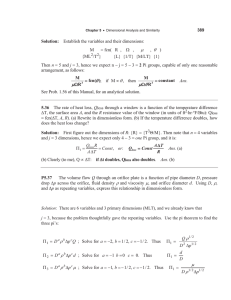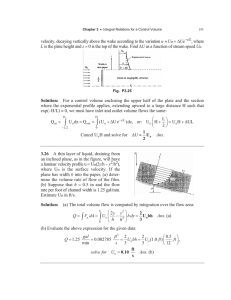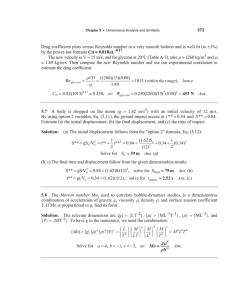U
advertisement
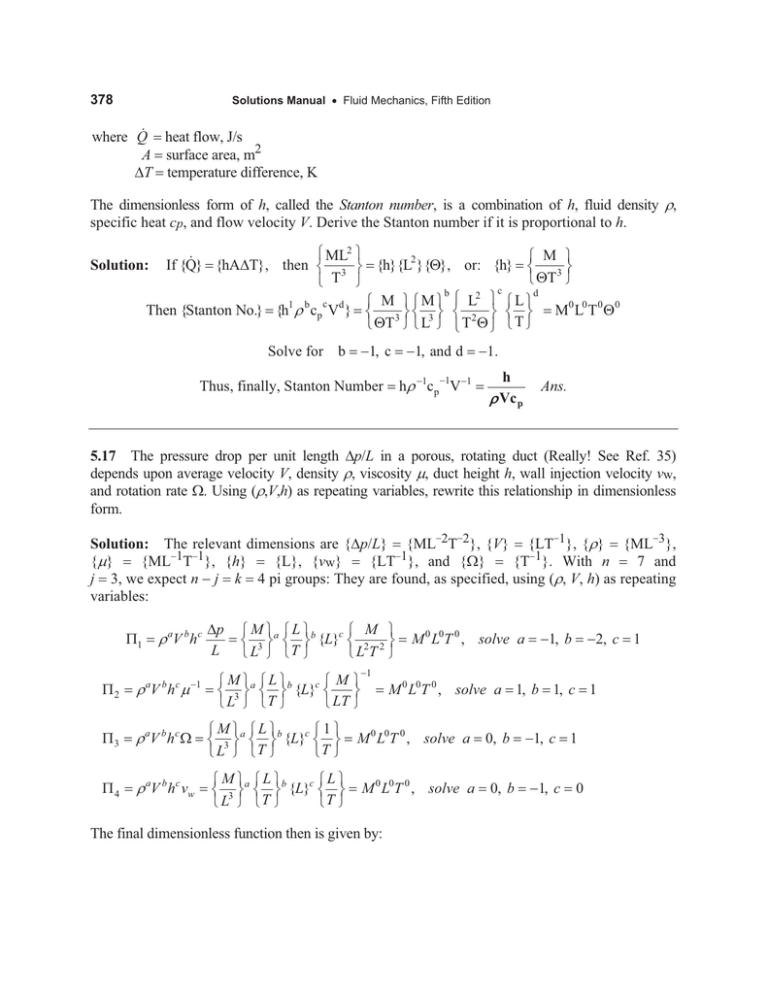
378
Solutions Manual x Fluid Mechanics, Fifth Edition
where Q heat flow, J/s
A surface area, m2
'T temperature difference, K
The dimensionless form of h, called the Stanton number, is a combination of h, fluid density U,
specific heat cp, and flow velocity V. Derive the Stanton number if it is proportional to h.
2
{hA'T}, then ­® ML ½¾ {h}{L2}{4}, or: {h} ®­ M ¾½
If {Q}
3
3
¯ 4T ¿
¯ T ¿
c
b
d
2
­ M ½­M½ ­ L ½ ­L½
1 b c d
Then {Stanton No.} {h U cp V } ® 3 ¾ ® 3 ¾ ® 2 ¾ ® ¾ M0 L0 T0 40
¯ 4T ¿ ¯ L ¿ ¯ T 4 ¿ ¯ T ¿
Solution:
Solve for
1, c
b
1, and d
1
hU 1cp V1
Thus, finally, Stanton Number
1.
h
U Vc p
Ans.
5.17 The pressure drop per unit length 'p/L in a porous, rotating duct (Really! See Ref. 35)
depends upon average velocity V, density U, viscosity P, duct height h, wall injection velocity vw,
and rotation rate :. Using (U,V,h) as repeating variables, rewrite this relationship in dimensionless
form.
Solution: The relevant dimensions are {'p/L} {ML2T2}, {V} {LT1}, {U} {ML3},
{ML1T1}, {h}
{L}, {vw}
{LT1}, and {:}
{T1}. With n
7 and
{P}
j 3, we expect n j k 4 pi groups: They are found, as specified, using (U, V, h) as repeating
variables:
U aV b h c
31
a
b c
'p
L
­ M ½ a ­ L ½b
c­ M ½
® 3 ¾ ® ¾ {L} ® 2 2 ¾
¯ L ¿ ¯T ¿
¯L T ¿
­ M ½ a ­ L ½b
c­ M ½
® 3 ¾ ® ¾ {L} ®
¾
¯ L ¿ ¯T ¿
¯ LT ¿
1
32
UV hP
33
U aV b h c : ®
34
U a V b h c vw
­ M ½ a ­ L ½b
­1½
{L}c ® ¾
3¾ ® ¾
¯ L ¿ ¯T ¿
¯T ¿
­ M ½ a ­ L ½b
c ­L ½
® 3 ¾ ® ¾ {L} ® ¾
¯ L ¿ ¯T ¿
¯T ¿
M 0 L0T 0 , solve a
1, b
2, c 1
1
M 0 L0T 0 , solve a 1, b 1, c 1
M 0 L0T 0 , solve a
M 0 L0T 0 , solve a
The final dimensionless function then is given by:
0, b
0, b
1, c 1
1, c
0
379
Chapter 5 x Dimensional Analysis and Similarity
31
fcn(3 2 , 3 3 , 3 4 ), or:
'p h
L UV 2
§ UVh :h vw ·
fcn ¨
,
, ¸
V V ¹
© P
Ans.
5.18 Under laminar conditions, the volume flow Q through a small triangular-section pore of side
length b and length L is a function of viscosity P, pressure drop per unit length 'p/L, and b. Using
the pi theorem, rewrite this relation in dimensionless form. How does the volume flow change if the
pore size b is doubled?
Solution: Establish the variables and their dimensions:
fcn('p/L ,
Q
{L3/T}
Then n
{M/L2T2} {M/LT} {L}
4 and j 3, hence we expect n j
31
P , b )
4 3 1 Pi group, found as follows:
('p/L)a ( P ) b (b)c Q1 {M/L2 T 2 }a {M/LT}b {L}c {L3 /T}1 M0 L0 T 0
M: a b 0; L: 2a – b c 3 0; T: 2a – b – 1 0,
solve
a
1, b
QP
( 'p/L)b4
31
1, c
constant
4
Ans.
Clearly, if b is doubled, the flow rate Q increases by a factor of 16. Ans.
5.19 The period of oscillation T of a water surface wave is assumed to be a function of density U,
wavelength O, depth h, gravity g, and surface tension Y. Rewrite this relationship in dimensionless
form. What results if Y is negligible?
Solution: Establish the variables and their dimensions:
T
{T}
fcn(
U
, O , h ,
g ,
Y
)
{M/L3} {L} {L} {L/T2} {M/T2}
Then n 6 and j 3, hence we expect n j
and selected by myself as follows:
6 3
Typical final result: T(g/O )1/2
3 Pi groups, capable of various arrangements
§h Y ·
fcn ¨ ,
2 ¸
© O U gO ¹
Ans.
